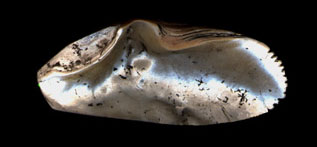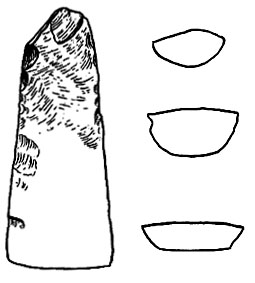
back *****************VOLUME 25 page 4 ***************** next page
Artifacts Recovered
*****I was all the while hoping to find a good representative artifact and now after an extensive amount of digging had almost given up the search. At this point I was exploring the bottom of the lowest layer, an artifact found here could provide just the clue needed. I excavated along this discoloured zone until I exposed some rather large bone fragments and decided take a picture of the intact bones with the last remaining photo of the roll (photo 25). After doing this I extracted and bagged the bones, then proceeded to dig a bit further into the deposit at the same depth. Only about 10 cm from the bones, I finally found an important intact artifact.

*****Y. H. Sinoto calls them graters when the edge is serrated, they are made of the thick hinge part of large pearl shells and in Tubuai I had previously found only one nearly complete example and a number of broken fragments to persuade me to think that this artifact was in fact in use at one time in Tubuai. (see Diagram 25.1) Also present in the Marquesas as well as Huahine this artifact is recognized as early by Sinoto. (See personal communication re the nearly complete AHOAPOFATU example illustrated Volume 18 (Diagram 18.26)
*****The following day I thought it best to return and try to establish the exact location of the findspot of the grater by measuring from the road as well as looking for dateable charcoal etc. Never imagining that more artifacts could be found as they seemed few and far between and work now made more difficult with the walls collapsing due to my undermining, anyway I cleared away the fallen rubble and again proceed to scrape away at the discoloured bottom part of the lowest layer not far from where I found the grater. I did find some more poor quality charcoal as well as bones and a large piece of worked pearl shell but more surprising was the sudden appearance of another grater only about 50 cm further south and placed at about the same level and in the same way in the discoloured bottom part (see Diagram 23.2) I had hardly extracted this second grater when I came across a complete well finished adze which was placed vertically next to the grater. the lowest part of the adze very near to, if not partially imbedded in the sterile clean layer below. Another 20 or so cm further on I came across a large terebra shell chisel as well as a sea urchin spine. For these tools to be found more or less together and all in good condition, one might wonder if they do not represent some sort of a cache?

*****The adze proves very interesting for it is rare Type 2Aa which has much in common with the early Hane adzes i.e. flat reversed trapezoidal (see Diagram 25.3 as well as Diagram 18.1 in Volume 18 ), however we see in this example a more extensive grinding which then is leading towards a more sub triangular form, this adze is untanged and heavily encrusted.
*****The terebra shell chisel, is in better condition than many others found elsewhere with the exterior surface pattern still evident. This artifact may also prove to be early as in Huahine.
*****The second grater, thicker than the first and wider, and is identical in form and size to one recovered at the Fa'ahia site, see Diagram 25.2 see also the rendering of the Fa'ahia specimen by Nicole Pigeot which is also pictured in Fig 11, page 28 of the 1983 report, Nouvelles recherches sur le site de Fa'ahia (M.T.I. publication).
*****Both ATIAHARA graters are in excellent condition, both have serrated teeth although the second appears somewhat worn. If one considers the fact that I have been fossicking all kinds of sites for many years and to date only one complete grater had been found and it being in a much deteriorated condition (recovered from ATIAHARA #5) while a few other incomplete fragments have turned up these too appear poorly preserved. How then might one explain the appearance of these two well preserved specimens?
*****The artifacts came from a 50 cm penetration of the eastern wall at a distance of 37-38 meters from the road. (measured from the east wall following the long axis of the trench). Coincidentally the first experimental transverse excavation was undertaken just beyond the 38 meter mark and the deep expermental hole excavated next to the east wall was perhaps only 60 cm beyond the cached artifacts, these excavations were fully photographed and further photographs were taken on the 22nd.
Return to the top of the page